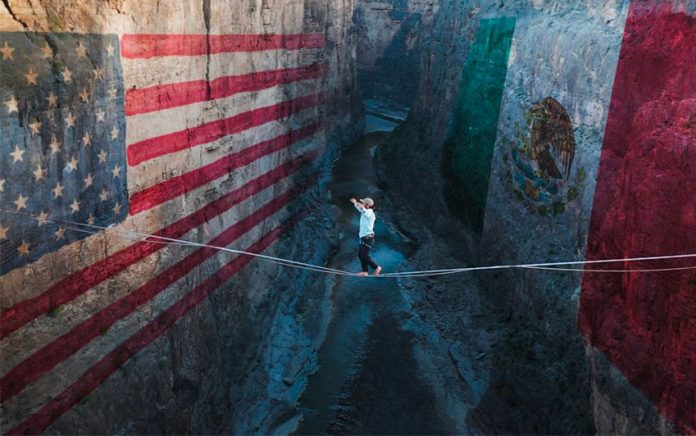At the end of January, one man from Mexico and another from the United States made a political point by crossing the border in a highly unusual way – they walked across a 150-meter-high slackline spanning the Rio Grande between Chihuahua and Texas.
The daring feat, documented in the newly-released short film The Imaginary Line, was the brainchild of 27-year-old Oregon man Corbin Kunst who, along with Jamie Maruffo of Mexico, completed the audacious crossing on January 25, the final day of a historic 35-day United States government shutdown precipitated by a standoff over funding for President Donald Trump’s border wall.
Prior to the crossing, a team from Mexico and another from the United States traveled down the Rio Grande to a section of the river between Big Bend National Park in Texas and the Cañon de Santa Elena National Park in Chihuahua.
There, the two teams – each placing complete trust in the other – connected cliffs on either side of the river with an almost 100-meter-long slackline.
“You’re putting your life in each other’s hands,” Kylor Melton, who made The Imaginary Line, told CNN. “It was so beautiful just to be a witness and to be a part of it.”

Both Kunst, who works as a ropes-course technician, and Melton, a 26-year-old filmmaker, said they checked with lawyers to ensure that they did everything legally.
However, the night before the crossing, as the Mexican and American teams huddled around a campfire, Kunst warned that they could still face legal consequences.
“While in every way we’re respecting the laws, this mission is heavy. You are all putting your freedom on the line,” he says in Melton’s film.
“We’re taking a stand against an unjust system and so we may be treated in an unjust way. So, what we’re here to do is deconstruct the belief that this line separates us.”
The next day – as the film shows – both Maruffo and Kunst were able to successfully cross the slackline to reach the United States and Mexico, respectively, and the two men even met at the midpoint of the line, where they shared a handshake and fist bump.
Kunst said the crossing was “an act of solidarity to show that people can come together even when political differences tear us apart.”
Before his crossing, he admits in The Imaginary Line to being “a little afraid, not because of the highline itself but because of what it stands for.”
“In a world that is constantly trying to tear us apart, we are here to come together to cross those imaginary lines that divide us and all I have to say is that we’re peoples that come from different lands but we’re all one,” Kunst said.
“We were there to promote cooperation,” he told CNN. “We want to have cooperation and trust all over the world, especially with our neighbors.”
In an interview with the magazine Outside, Kunst said the idea first occurred to him after he saw a photograph of the Santa Elena canyon.
“I thought, ‘how cool would it be to break this epic highline over the Rio Grande . . .?’”
He explained that the U.S. team was made up of friends, adding that he also knows everyone from Mexico who took part in the project and “already had trust in them.”
Melton said the two men fell “once or twice” but Kunst added that “highlining is actually a very safe sport – we were always tethered to the line.”
Asked what he was thinking about while performing the “stunt,” Kunst responded:
“I don’t like thinking of it as a stunt. It was much more than that . . . For me it was the most important slackline I have ever walked. It had so much power in it . . . The idea wouldn’t have gone anywhere unless people also felt that this was a powerful message. So, for me, as I was walking the line, that’s what was going on in my head . . . After I finished, I was pretty blissed out. I was ecstatic.”
As for the film, which premiered online on Sunday, Melton told Mexico News Daily via e-mail that his “greatest hope” was to “create a movement that goes far beyond ourselves using this highline as a medium for sparking a conversation and to create a positive shift in our world.”
